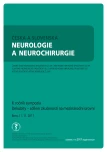Pressure Ulcers Represents a Constant Nightmare for Me
Authors:
L. Veverková
; K. Krejsová; M. Reška; P. Vlček; J. Žák; J. Konečný; M. Páral
Authors‘ workplace:
LF MU a FN u sv. Anny v Brně
; I. chirurgická klinika
Published in:
Cesk Slov Neurol N 2017; 80(Supplementum 1): 61-64
Category:
Original Paper
doi:
https://doi.org/10.14735/amcsnn2017S61
Overview
Aim:
Analysis of patients who had been operated with consequent development of pressure ulcer in 2016 hospitalized at 1st Surgical Clinic (St. Anne’s Hospital).
Methods:
Retrospective analyses of administrative data and specific electronic tool (I-hojeni.cz). Statistical analyses was performed with Pearson chi-square (statistical significance value 0.05).
Results:
From total of 3,807 hospitalized patients most of them (n = 3,301; 85.3%) underwent surgery. Newly developed (hospital acquired) decubitus was detected in 49 patients (25 women and 24 men). The average age of patients was 80.4 years. BMI was on average 25.37, the length of hospitalization reached 26.67 days on average. Average length of the period between admission and surgical intervention was 2.79 days (0to 16 days). One patient had decubitus on 5 spots and 3 patients on 3 spots, i.e. on average one patient within our group had 1.42 decubitus. The most frequent localization on gluteus followed by heels. We identified no statistically significant relation between BMI and development of decubitus (p > 0.05). Occurrence of decubitus was significantly related to patien’ age and length of hospitalization. In case of BMI, we confirmed that development of pressure sore is independent of BMI (p > 0.05). In case of other variables we verified the existence of dependence between the age of patient and development of decubitus (p < 0.05). A group of patients treated for trauma and after chest surgery was analysed in more detail. We have demonstrated statistically significant relation between occurrence of decubitus in the operated patients and the presence of a neurological anamnesis in the patient‘s anamnesis (p = 0.08). Out of our group, three patients died of signs of sepsis.
Conclusion:
Despite of all preventive measures, decubitus occur especially in trauma patients and patients with neurology diagnosis treated by surgical means.
Key words:
decubitus – pressure ulcer – incidence – trauma – inflammatory process in chest
The authors declare they have no potential conflicts of interest concerning drugs, products, or services used in the study.
The Editorial Board declares that the manuscript met the ICMJE “uniform requirements” for biomedical papers.
Sources
1. World Health Organization. WHO Guidelines for safe surgery 2009: safe surgery saves lives. [online]. Available from URL: http:/ /whqlibdoc.who.int/ publications/ 2009/ 9789241598552_eng.pdf.
2. National Institute for Health and Clinical Excellence. Appendix H: Methodology checklist: economic evaluations. The Guidelines Manual. London: National Institute for Health and Clinical Excellence 2009:200– 7.
3. Gottrup F, Apelqvist J, Price P. Outcomes in controlled and comparative studies on non-healing wounds. J Wound Care 2010;19(6):237– 68.
4. Dowd SE, Sun Y, Secor PR, et al. Survey of bacterial diversity in chronic wounds using pyrosequencing, DGGE, and fullribosome shotgun sequencing. BMC Microbiol 2008;8:43– 58. doi: 10.1186/ 1471-2180-8-43.
5. Percival S, Cutting K, eds. Microbiology of Wounds. New York: 2010 New York: CRC Press 2010.
6. Cereda E, Gini A, Pedrollo C, et al. Disease-specific, versus standard, nutritional support for the treatment of pressure ulcers in institutionalized olderadults: a randomized controlled trial. J Am Geriatr Soc2009;57(8):1395– 402. doi: 10.1111/ j.15325415.2009.02351.x.
7. Pokorna A, Saibertova S, Vasmanska S, et al. Registers of pressure ulcers in an international context. Cent Eur J Nurs Midw 2016;7(2):444– 52. doi: 10.15452/ CEJNM.2016.07.0013.
8. Emily Haesler, ed. National Pressure Ulcer Advisory Panel, European Pressure Ulcer Advisory Panel and Pan Pacific Pressure Injury Alliance. Prevention and Treatment of Pressure Ulcers: Quick Reference Guide. Perth, Australia: Cambridge Media 2014.
9. Demarre L, Van Lancker A, Van Hecke A, et al. The cost of prevention and treatment of pres sure ulcers:a systematic review. Int J Nurs Stud 2015;52(11):1754– 74. doi: 10.1016/ j.ijnurstu.2015.06.006.
10. Mandal A. Role of topical negative pressure in pressure ulcer management. J Wound Care 2007;16(1):33– 5.
11. Black JM, Cuddigan JE, Walko MA, et al. Medical device related pressure ulcers in hospitalized patients. Int Wound J 2010;7(5): 358– 65. doi: 10.1111/ j.1742-481X.2010.00699.x.
12. Pokorna A, Benešová K, Mužik J, et al. The Pressure Ulcers Monitor ing in Patiens with Neurological Diseases – Analyse of the National Register of Hospitalized Patient. Cesk Slov Neurol N 2016;79/ 112(Suppl 1):S8– 14. doi: 10.14735/ amcsnn2016S8.
Labels
Paediatric neurology Neurosurgery NeurologyArticle was published in
Czech and Slovak Neurology and Neurosurgery

2017 Issue Supplementum 1
- Metamizole vs. Tramadol in Postoperative Analgesia
- Memantine in Dementia Therapy – Current Findings and Possible Future Applications
- Memantine Eases Daily Life for Patients and Caregivers
- Metamizole at a Glance and in Practice – Effective Non-Opioid Analgesic for All Ages
- Advances in the Treatment of Myasthenia Gravis on the Horizon
Most read in this issue
- Validaton of Nursing Diagnosis of Acute and Chronic Pain According to NANDA International in the Patients with Wound
- Employment of Flap Surgery in Pressure Ulcers Surgical Treatment
- Differential Diagnosis in Pressure Ulcers and Medical Devices
- Pressure Ulcers Represents a Constant Nightmare for Me
